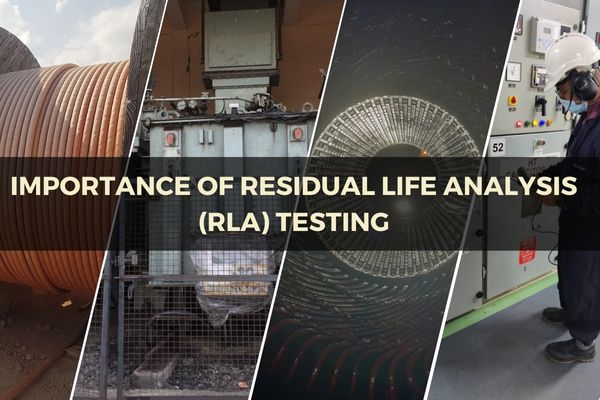Importance of Residual Life Analysis (RLA) Testing
RLA, also known as Residual Life Assessment, is a critical process in the maintenance and operation of industrial equipment, including motors, generators, cables, transformers, and switchgear. The objective of RLA is to determine the remaining useful life of an asset and to take appropriate actions to ensure its safe and efficient operation.

Reasons for RLA Testing:
- Safety: RLA helps ensure the safety of personnel and equipment by identifying and addressing potential risks before equipment failure.
- Cost Savings: RLA helps reduce maintenance and repair costs by identifying and correcting problems early, so that secondary damage is avoided and downtime is minimized.
- Reliability: Regular RLA helps maintain the reliability of industrial equipment by detecting and correcting incipient defects.
- Compliance: RLA is often necessary to comply with industry regulations and avoid fines. For e. g., the amended Indian Electricity Act requires that all transformers above 66 kV should have some form of online monitoring.
- Proactive Maintenance: Regular RLA enables operators to take a proactive approach to maintenance and improve overall facility efficiency.
RLA Methods
- On-line Testing: Electrical Signature Analysis, Vibration Analysis, Ultrasound, Infrared Thermography, On-Line Partial Discharge, etc. can detect many defects in motors, cables, transformers & switchgear.
- Off-Line Testing: In-depth evaluation of insulation requires testing the electrical assets in the de-energized condition using methods such as Tan Delta, VLF, SFRA, DFRA, Off-Line PD, etc.
- Invasive Testing: Certain types of faults such as stator core degradation, loose wedges, etc. can only be detected after opening the motor or generator and performing additional tests.
- Laboratory & Desk Studies: While field testing is critical, lab. tests like soil resistivity, oil analysis, etc., and analytical studies like Ampacity, Correlation, etc. are needed to combine all the data, find dependencies and see the bigger picture.
- Probabilistic Methods: Statistical analysis to determine the likelihood of failure based on current conditions and operating conditions.
Conducting RLA Studies
- Planning: Define the scope and objectives of the study with equipment operators and maintenance personnel.
- Testing: Conduct thorough diagnostic tests by a team of trained technicians and engineers.
- Analysis: Collate all of the acquired data along with historical records and process parameters. Analyze the motor/ generator/ cable/ transformer/ switchgear in totality to determine its useful life.
CONCLUSION:
RLA is essential to ensure the safety, reliability, and efficiency of industrial equipment. Regular RLA also helps in regulatory compliance, reducing maintenance costs, and improving plant productivity. At DIATECH, we provide professional RLA services using the latest technologies and procedures. Contact us today for a quote.
